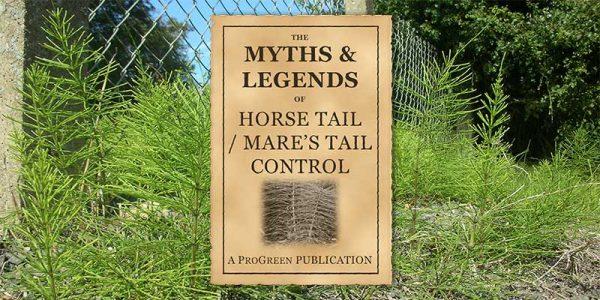The Myths of Horsetail Removal
When scouring the internet for solutions to control the troublesome horsetail/mare’s tail weed, there are unfortunately many home remedies that are apparently “the best ways to gain control”. Today we will delve into the myths and see what the truths actually are.
Myth 1: Killing horsetail with bleach
There are many articles out there advertising that bleach is a great way of controlling horsetail. The idea behind it is that the bleach soaks through the roots of the plant destroying them as it would with any other living organism. This method, however, is damaging to the areas that it is applied to. Not only is bleach extremely poisonous to anything that would potentially eat the leaves or vegetation it has touched, it causes the soil pH to become very high making it near enough impossible to grow anything else in that areas for several months if not longer.
Myth 2: Killing horsetail with vinegar
The internet is rife with advice on how to make up a solution of vinegar with salt or washing up liquid. The vinegar and salt are there to dry up the plant/weed, putting it through extreme drought-like conditions eventually causing it to die. The added washing up liquid is said to work as a sticking agent getting the vinegar solution to stick to the weed and theoretically improve the efficacy of the solution. So, why is this not a good method? Vinegar is non-selective so it will kill anything that it is applied to not only plants but to beneficial microbes within the soil. On top of this, spraying it on a plant might only kill the top of the plant and does not affect the roots which, when it comes to horsetail, will not help you gain overall control of the weed. Alongside this with the addition of salt in the mixture, this will cause long-term damage to the soil.
Myth 3: Killing horsetail with WD-40
Recently there have been many videos and articles circling the internet on how WD-40 is an effective method of killing horsetail. However, this product should not be used as a weed control product. Once applied to the plant/weed you are wishing to kill the WD-40 will work its way through the plant and into the soil. When it has reached the soil it will then poison the area making it extremely difficult to grow anything in that area so although you think you have solved one problem it will have caused a larger one.
Myth 4: Lime can control horsetail
There are many statements out there that applying a lime fertiliser to the area containing horsetail can help gain control. Many people say that horsetail only likes to grow in acidic soil so neutralising this with the lime would make the horsetail unable to survive. This is however false. Horsetail has been known to thrive in a wide variety of locations including those with a neutral soil pH, so this method will not stop the growth.
Myth 5: Covering areas affected by horsetail with a black covering/tarpaulin
The idea of covering the area with a black covering is backed by the thought that the horsetail won’t be able to survive without access to the sunlight. This is untrue! Once the black covering is removed the horsetail can spring back into life with shoots popping up from the ground. It is said that horsetail rhizomes can remain dormant under the ground for over 100 years and once it has the right conditions they will happily grow again.
We do not recommend any of the above ideas. To find out how to gain good control of horsetail/mare’s tail check out our “How to control horsetail/mare’s tail” By Problem page.





